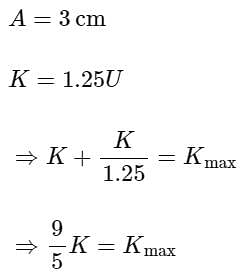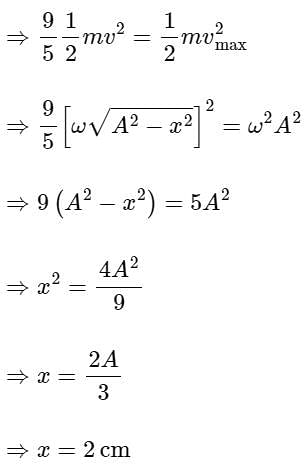JEE Exam > JEE Questions > The amplitude of a particle executing SHM is ...
Start Learning for Free
The amplitude of a particle executing SHM is 3 cm. The displacement at which its kinetic energy will be 25% more than the potential energy is: ___________ cm
Correct answer is '2'. Can you explain this answer?
Verified Answer
The amplitude of a particle executing SHM is 3 cm.The displacement at ...


Most Upvoted Answer
The amplitude of a particle executing SHM is 3 cm.The displacement at ...
To find the displacement at which the kinetic energy is 25% more than the potential energy, we can start by understanding the relationship between kinetic energy (KE) and potential energy (PE) in simple harmonic motion (SHM).
In SHM, the total mechanical energy (E) remains constant throughout the motion. This means that the sum of kinetic energy and potential energy at any point in time is constant.
E = KE + PE
Since the amplitude of the particle executing SHM is given as 3 cm, we can express the potential energy and kinetic energy in terms of the displacement (x) from the equilibrium position.
Potential Energy (PE):
The potential energy at any point in SHM is given by the equation:
PE = (1/2)kx^2
where k is the force constant or the spring constant.
Kinetic Energy (KE):
The kinetic energy at any point in SHM is given by the equation:
KE = (1/2)mv^2
where m is the mass of the particle and v is its velocity.
Finding the displacement:
To find the displacement at which the kinetic energy is 25% more than the potential energy, we need to set up the equation:
KE = 1.25 * PE
Substituting the equations for KE and PE:
(1/2)mv^2 = 1.25 * (1/2)kx^2
Canceling the common factors and simplifying:
mv^2 = 1.25 * kx^2
Since v = ω√(A^2 - x^2), where ω is the angular frequency and A is the amplitude, we can substitute this value in the equation:
m(ω√(A^2 - x^2))^2 = 1.25 * kx^2
Simplifying further:
mω^2(A^2 - x^2) = 1.25kx^2
mω^2A^2 - mω^2x^2 = 1.25kx^2
mω^2A^2 = (1.25k + mω^2)x^2
Dividing both sides by (1.25k + mω^2):
(mω^2A^2)/(1.25k + mω^2) = x^2
Taking the square root of both sides:
x = √((mω^2A^2)/(1.25k + mω^2))
Since we know the amplitude A, we can substitute the given values into this equation to find the displacement at which the kinetic energy is 25% more than the potential energy.
x = √((mω^2(3)^2)/(1.25k + mω^2))
However, without specific values for mass (m), angular frequency (ω), and spring constant (k), we cannot calculate the exact displacement. Hence, we cannot determine the specific value for the displacement.
In SHM, the total mechanical energy (E) remains constant throughout the motion. This means that the sum of kinetic energy and potential energy at any point in time is constant.
E = KE + PE
Since the amplitude of the particle executing SHM is given as 3 cm, we can express the potential energy and kinetic energy in terms of the displacement (x) from the equilibrium position.
Potential Energy (PE):
The potential energy at any point in SHM is given by the equation:
PE = (1/2)kx^2
where k is the force constant or the spring constant.
Kinetic Energy (KE):
The kinetic energy at any point in SHM is given by the equation:
KE = (1/2)mv^2
where m is the mass of the particle and v is its velocity.
Finding the displacement:
To find the displacement at which the kinetic energy is 25% more than the potential energy, we need to set up the equation:
KE = 1.25 * PE
Substituting the equations for KE and PE:
(1/2)mv^2 = 1.25 * (1/2)kx^2
Canceling the common factors and simplifying:
mv^2 = 1.25 * kx^2
Since v = ω√(A^2 - x^2), where ω is the angular frequency and A is the amplitude, we can substitute this value in the equation:
m(ω√(A^2 - x^2))^2 = 1.25 * kx^2
Simplifying further:
mω^2(A^2 - x^2) = 1.25kx^2
mω^2A^2 - mω^2x^2 = 1.25kx^2
mω^2A^2 = (1.25k + mω^2)x^2
Dividing both sides by (1.25k + mω^2):
(mω^2A^2)/(1.25k + mω^2) = x^2
Taking the square root of both sides:
x = √((mω^2A^2)/(1.25k + mω^2))
Since we know the amplitude A, we can substitute the given values into this equation to find the displacement at which the kinetic energy is 25% more than the potential energy.
x = √((mω^2(3)^2)/(1.25k + mω^2))
However, without specific values for mass (m), angular frequency (ω), and spring constant (k), we cannot calculate the exact displacement. Hence, we cannot determine the specific value for the displacement.

|
Explore Courses for JEE exam
|

|
Similar JEE Doubts
The amplitude of a particle executing SHM is 3 cm.The displacement at which its kinetic energy will be 25%more than the potential energy is: ___________ cmCorrect answer is '2'. Can you explain this answer?
Question Description
The amplitude of a particle executing SHM is 3 cm.The displacement at which its kinetic energy will be 25%more than the potential energy is: ___________ cmCorrect answer is '2'. Can you explain this answer? for JEE 2025 is part of JEE preparation. The Question and answers have been prepared according to the JEE exam syllabus. Information about The amplitude of a particle executing SHM is 3 cm.The displacement at which its kinetic energy will be 25%more than the potential energy is: ___________ cmCorrect answer is '2'. Can you explain this answer? covers all topics & solutions for JEE 2025 Exam. Find important definitions, questions, meanings, examples, exercises and tests below for The amplitude of a particle executing SHM is 3 cm.The displacement at which its kinetic energy will be 25%more than the potential energy is: ___________ cmCorrect answer is '2'. Can you explain this answer?.
The amplitude of a particle executing SHM is 3 cm.The displacement at which its kinetic energy will be 25%more than the potential energy is: ___________ cmCorrect answer is '2'. Can you explain this answer? for JEE 2025 is part of JEE preparation. The Question and answers have been prepared according to the JEE exam syllabus. Information about The amplitude of a particle executing SHM is 3 cm.The displacement at which its kinetic energy will be 25%more than the potential energy is: ___________ cmCorrect answer is '2'. Can you explain this answer? covers all topics & solutions for JEE 2025 Exam. Find important definitions, questions, meanings, examples, exercises and tests below for The amplitude of a particle executing SHM is 3 cm.The displacement at which its kinetic energy will be 25%more than the potential energy is: ___________ cmCorrect answer is '2'. Can you explain this answer?.
Solutions for The amplitude of a particle executing SHM is 3 cm.The displacement at which its kinetic energy will be 25%more than the potential energy is: ___________ cmCorrect answer is '2'. Can you explain this answer? in English & in Hindi are available as part of our courses for JEE.
Download more important topics, notes, lectures and mock test series for JEE Exam by signing up for free.
Here you can find the meaning of The amplitude of a particle executing SHM is 3 cm.The displacement at which its kinetic energy will be 25%more than the potential energy is: ___________ cmCorrect answer is '2'. Can you explain this answer? defined & explained in the simplest way possible. Besides giving the explanation of
The amplitude of a particle executing SHM is 3 cm.The displacement at which its kinetic energy will be 25%more than the potential energy is: ___________ cmCorrect answer is '2'. Can you explain this answer?, a detailed solution for The amplitude of a particle executing SHM is 3 cm.The displacement at which its kinetic energy will be 25%more than the potential energy is: ___________ cmCorrect answer is '2'. Can you explain this answer? has been provided alongside types of The amplitude of a particle executing SHM is 3 cm.The displacement at which its kinetic energy will be 25%more than the potential energy is: ___________ cmCorrect answer is '2'. Can you explain this answer? theory, EduRev gives you an
ample number of questions to practice The amplitude of a particle executing SHM is 3 cm.The displacement at which its kinetic energy will be 25%more than the potential energy is: ___________ cmCorrect answer is '2'. Can you explain this answer? tests, examples and also practice JEE tests.

|
Explore Courses for JEE exam
|

|
Signup for Free!
Signup to see your scores go up within 7 days! Learn & Practice with 1000+ FREE Notes, Videos & Tests.
























